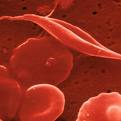Marrow Transplants Hold Cure for Sickle Cell
 Using a new, less toxic approach to bone marrow transplantation, doctors at UPMC Children's Hospital of Pittsburgh and two other centers have completely cured sickle cell anemia in six out of seven patients.
Using a new, less toxic approach to bone marrow transplantation, doctors at UPMC Children's Hospital of Pittsburgh and two other centers have completely cured sickle cell anemia in six out of seven patients.
Sickle cell anemia, a hereditary blood disorder that disproportionately affects African-Americans, can cause pain, organ damage, high blood pressure and strokes, and shortens life spans by 25 to 30 years. For years doctors have known the only cure for sickle cell anemia is bone marrow transplants. The new study has found a way that uses a much less intensive regimen of chemotherapy and radiation to prepare patients for the transplant.
Five of the cured patients were treated by Dr. Lakshmanan Krishnamurti a Children's cancer specialist and lead author of the study. They received bone marrow from siblings after the less intensive preparation of their bodies for the transplant.
The study being published in the journal Biology of Blood and Marrow Transplantation reported that the less intensive use of chemotherapy and radiation before the transplants cut the risks that come from completely wiping out a patient's bone marrow before the procedure.
In conventional marrow transplants, in hopes the transplanted cells will take over the function,doctors use heavy doses of chemo and radiation to completely wipe out the patient's blood-producing marrow. The procedure is risky and some patients die as a result of infections or an attack on their bodies by the transplanted cells known as graft-vs.-host disease.
Cancer patients, take the risks as an acceptable trade-off if the only other option is dying from the malignancy. Sickle cell patients on the other hand don't face the same risk of dying from their disease, Dr. Krishnamurti said, but often when they are told a typical marrow transplant will keep them in the hospital for weeks and make them very sick, many refuse to go through with it.
Dr. Krishnamurti believes "if you can make the transplant less toxic, people are more likely to go forward with it."
Mary Fabry, a sickle cell researcher at Albert Einstein College of Medicine in New York said, beta thalassemia, another red blood cell disorder which is more prevalent, and seen in Europe has seen transplants as treatment more commonly as most patients with a transplant are likely to die in their 20’s and 30’s. The newer treatments for many sickle cell patients in America allow them to live into their 50’s or longer so there has been less urgency to get marrow transplants. "The really big problem with transplantation in sickle cell disease is that the outcome of the disease has been so unpredictable."